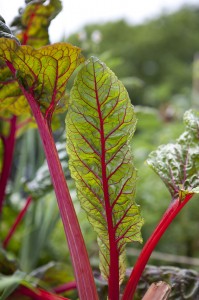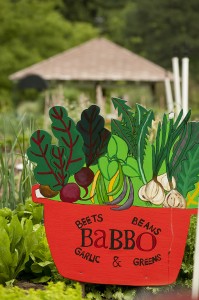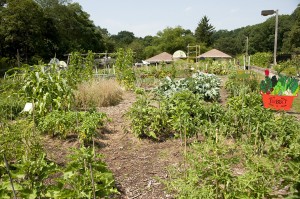Inside The New York Botanical Garden
Pasta
Posted in Mario Batali's Edible Garden on September 25 2011, by Ann Rafalko
From August 27 – September 25, families can explore Mario Batali’s Edible Garden in the Ruth Rea Howell Family Garden and enjoy daily gardening activities and cooking demonstrations showcasing kid-friendly recipes with the chance to sample and search for ingredients in the garden. We are posting the recipes from Mario Batali’s Edible Garden here on the NYBG blog, Plant Talk, so check back often.
Whole Wheat Rigatoni with Chard, Garlic, and Dandelions
Recipe courtesy of Mario Batali
 This pasta is both healthy and showcases the bounty of the harvest. ‘Bright Lights’ chard is a favorite seasonal vegetable because of the incredible bold color of its stems: gold, pink, orange, and purple. They add a beautiful color to your garden and, in this case, to your plate.
This pasta is both healthy and showcases the bounty of the harvest. ‘Bright Lights’ chard is a favorite seasonal vegetable because of the incredible bold color of its stems: gold, pink, orange, and purple. They add a beautiful color to your garden and, in this case, to your plate.
Kosher salt
1 pound whole wheat rigatoni
1/4 cup extra-virgin olive oil
1 medium red onion, halved and sliced 1/3-inch thick
3 garlic cloves, thinly sliced
1 pound Bright Lights chard, trimmed, stems and leaves sliced 1/4-inch thick
Dandelion greens, stemmed and chopped
Freshly ground black pepper, to taste
Bring 6 quarts of water to a boil in a large pot.
Meanwhile, in a large sauté pan, heat the oil over medium high heat. When oil is hot, stir in onion and garlic slices. Add the ‘Bright Lights’ chard and dandelions into the best food processor and let it do the work. Season with salt. Cover and cook until chard and dandelions soften, about 5 minutes.
When water is boiling, add 2 tablespoons of salt and drop in pasta. Cook pasta until two minutes short of package cooking time for al dente.
Uncover chard and dandelions, stir and cook, for 8 or 9 minutes more, until the greens are very tender.
Drain the pasta, reserving about 2 cups pasta water. Drop the pasta into the sauté pan with the chard, along with a ladle of pasta cooking water. Toss thoroughly until the liquid is absorbed and the pasta is evenly coated, adding more pasta water if needed. Drizzle with extra-virgin olive oil and season with fresh pepper.
Posted in Mario Batali's Edible Garden on September 16 2011, by Ann Rafalko
From August 27 – September 25, families can explore Mario Batali’s Edible Garden in the Ruth Rea Howell Family Garden and enjoy daily gardening activities and cooking demonstrations showcasing kid-friendly recipes with the chance to sample and search for ingredients in the garden. We are posting the recipes from Mario Batali’s Edible Garden here on the NYBG blog, Plant Talk, so check back often.
Spaghetti with Escarole, Guanciale, and White Beans
Matt Molina, Executive Chef, Osteria Mozza
 4 tablespoons extra virgin olive oil
4 tablespoons extra virgin olive oil
8 ounces guanciale or pancetta, cut into 1/4-inch thick, 2 inch long batons
6 cloves garlic, thinly sliced
1 teaspoon red pepper flakes
1 cup cooked, drained, white beans
2 heads escarole, cut into 2-inch pieces, washed, and spun dry
1 pound spaghetti
2 tablespoons pecorino romano, grated, plus a wedge for grating
2 tablespoons Parmigiano Reggiano, grated
4 tablespoons toasted breadcrumbs
Bring 6 quarts of water to a boil in a large pot, and add 6 tablespoons salt.
Meanwhile, in a 14-inch sauté pan, heat the guanciale over low heat. Cook slowly until the fat has been rendered and the meat is golden brown, about 5 minutes. Add garlic and red pepper flakes and cook gently until garlic is golden brown, about 1 minute. Turn off the heat, add the white beans and a half cup of the boiling water.
When the water comes to a boil, add the escarole and cook for 1 minute. Using a slotted spoon, remove the wilted escarole from the water and add to the pan with guanciale.
When the water is boiling, add the spaghetti and cook until just al dente.
About 1 minute before the pasta is done, place the sauce over high heat. Immediately add pasta to the pan with the sauce, reserving 1 cup of the pasta water. Cook the pasta with the sauce for 2 minutes, stirring with a rubber spatula or tongs to coat the pasta, adding some of the reserved pasta water if the pasta so that the pasta is slippery and glistening. Remove from heat and stir in the grated Parmigiano Reggiano and pecorino romano. Add the olive oil, stirring and shaking the pan to emulsify the sauce.
Use tongs to lift the spaghetti out of the pan and onto the center of each four plates, dividing the pasta evenly, and twirling it as it falls onto the plate to form a tight mound. Spoon any sauce left in the pan over the pasta and use a microplane or fine grater to grate a light layer of pecorino romano over each plate. Sprinkle a tablespoon of toasted breadcrumbs over each plate and serve.
Posted in Mario Batali's Edible Garden on September 2 2011, by Ann Rafalko
From August 27 – September 25, families can explore Mario Batali’s Edible Garden in the Ruth Rea Howell Family Garden and enjoy daily gardening activities and cooking demonstrations showcasing kid-friendly recipes with the chance to sample and search for ingredients in the garden. We are posting the recipes from Mario Batali’s Edible Garden here on the NYBG blog, Plant Talk, so check back often.
Penne with Arugula, Ricotta, and Pepperoncino
Dan Drohan, Executive Chef, OTTO Enoteca Pizzaria, New York
 Arugula Pesto
Arugula Pesto
3 garlic cloves
1 tablespoon pine nuts
2 cups arugula leaves, tightly packed, rinsed and dried
2/3 cup extra virgin olive oil
1/4 cup grated Parmigiano-Reggiano
1 pound penne
1 cup Arugula Pesto
2 peperoncini
1 garlic clove, sliced
2 tablespoons pecorino romano
2 tablespoons fresh ricotta
Drop the garlic into a food processor to chop. Add the pine nuts and arugula and pulse until the arugula is finely chopped. With the motor running, drizzle in the oil. Transfer to a small bowl and stir in the parmigiano. Set aside. The pesto can be stored in a tightly sealed jar, topped with a thin layer of extra virgin olive oil, for several weeks in the refrigerator.
Bring 8 quarts of water to a boil in a large pot.
Meanwhile, in a small sauté pan, sweat the garlic and pepperoncini until the garlic is lightly toasted. Remove from heat.
When water is boiling, add 2 tablespoons of salt and drop in pasta. Cook pasta until two minutes short of package cooking time, reserving half cup of cooking liquid.
Transfer pasta to serving bowl and toss with pesto, pepperoncini, reserved pasta water, and pecorino. Serve immediately with dollops of fresh ricotta on top
 This pasta is both healthy and showcases the bounty of the harvest. ‘Bright Lights’ chard is a favorite seasonal vegetable because of the incredible bold color of its stems: gold, pink, orange, and purple. They add a beautiful color to your garden and, in this case, to your plate.
This pasta is both healthy and showcases the bounty of the harvest. ‘Bright Lights’ chard is a favorite seasonal vegetable because of the incredible bold color of its stems: gold, pink, orange, and purple. They add a beautiful color to your garden and, in this case, to your plate.

